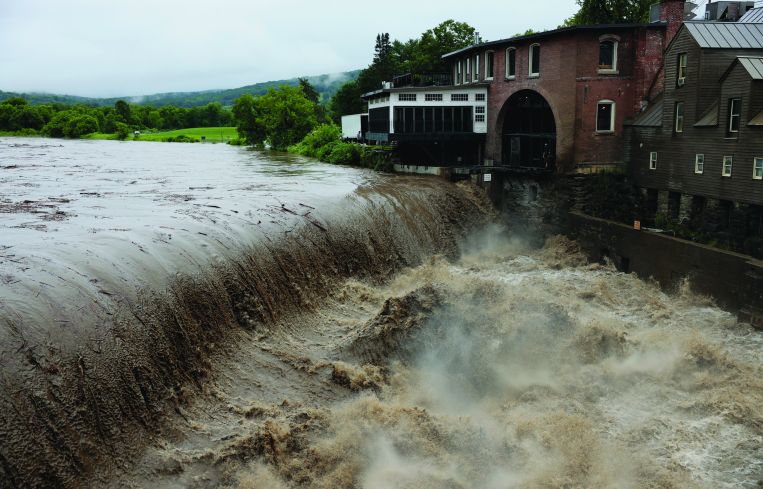Rightsizing Stormwater Design — Right From the Start — in Unpredictable Times
By Kathereen Shinkai May 6, 2025 11:00 am
reprints
Climate change and extreme weather events are taking a toll around the country. Rainfall levels are rewriting records. Places that once seemed immune to flooding are no longer so.
Every commercial real estate project now faces the challenge of designing a stormwater management system appropriate to the site, budget and risk — not just following boilerplate storm standards or aiming blindly for a 100-year flood threshold. Planning for storms with a 1 percent chance of occurring in any given year can be expensive and, frankly, futile. Infrastructure and transit connections remain vulnerable. Once neighboring land floods, your project may still be underwater.
Changing conditions call for a new approach. Flood resilience can no longer be relegated to the margins of a project. If property owners want to reduce risk without overspending, civil engineers need to be in the room from the beginning — helping align flood planning with grading, layout, infrastructure and long-term performance goals. That’s the only way to hit the sweet spot between overengineered and exposed.

Site review. Site decisions made before civil engineering enters the picture can have lasting consequences. A client once shared a beautifully rendered campus plan. But a quick review revealed that the buildings ignored the site’s 80-foot elevation change. Massive retaining walls would be needed to support the structures — an expensive fix for a problem that never should have existed.
In an integrated design process, the civil engineer contributes to site layout from the start, helping to identify flood plain zones, coordinate utility tie-ins, and ensure that the project’s physical realities support the design vision. That’s still unusual in traditional architectural practice, but I suspect it won’t be for long.
Grading. Regardless of terrain, every site needs to direct how and where water will drain. If that work isn’t informed by civil engineering early on, it can lead to costly rework to make the site resilient.
One of the most cost-effective ways to address grading is to balance excavation and fill — using the earth that’s already on site to build embankments or level surfaces. That approach can significantly reduce hauling costs and environmental impacts, but it works only if civil engineers are involved before key design decisions are locked in. That’s particularly important as more properties face increasingly intense rainfall and runoff.
Balancing use and resilience. Stormwater strategies directly affect what gets built and where — especially on tight or complex sites. A civil engineer’s job is to help the team navigate the trade-offs. Urban and industrial projects may need underground detention or proprietary systems. Sites with more room might use basins and swales to slow and filter runoff. Either way, the relationship between open space and built footprint determines what’s possible.
Designing buildings without a civil lens often leaves owners with fewer, more expensive options for resilience — or, worse, none that meet code. These aren’t just technical decisions. Many clients today are interested in visible, natural retention features that improve aesthetics, educate users, or support sustainability goals. But those opportunities come into focus only with early, cross-disciplinary planning.
Budget. Stormwater systems can be invisible to occupants, but they’re a major line item for owners — especially when space is limited or underground systems are required. Costs vary dramatically depending on how much treatment is needed, the volume of water, and what pollutants are present. Drywells and underground systems require deep excavation, pumping and specialized infrastructure. Ignore these costs, and an owner may see the project delayed or derailed entirely. Civil engineers are needed to voice the implications and trade-offs before a budget is committed elsewhere.
Maintenance. Even a well-designed system can cause problems if it isn’t maintained. Some systems require regular debris removal or periodic replacement of filtration media. Others demand specialized inspections. These costs and responsibilities aren’t always obvious in early design phases — but they matter, and they last. When the team evaluates options early, owners can make better-informed decisions about life cycle costs, staffing and compliance requirements.
A new way of working. Developers today face more complexity and more climate risk than ever before. The traditional, architecture-led process isn’t equipped to handle it. Resilience doesn’t live in one discipline — it lives in the overlaps. Clients should demand more integrated teams, with civil engineers engaged early to help shape strategy and priorities. The earlier we jump in, the more value we can bring — aligning technical systems with site realities and project goals.
And the payoff is clear: Projects that are better prepared for storms, smarter about budget, and more capable of adapting to a rapidly changing world.
Kathereen Shinkai is the director of civil engineering at LPA Design Studios.


